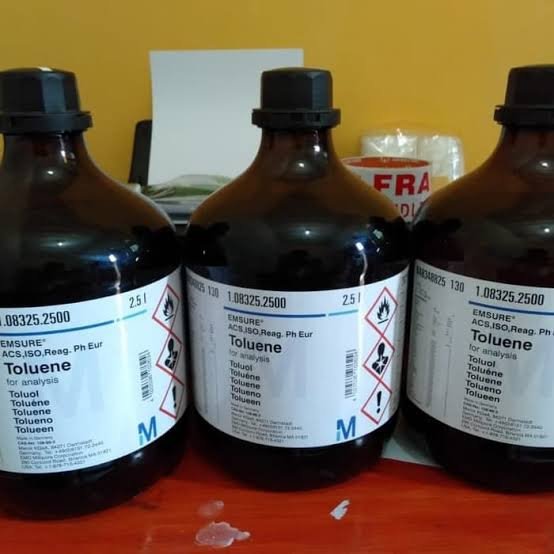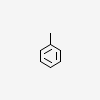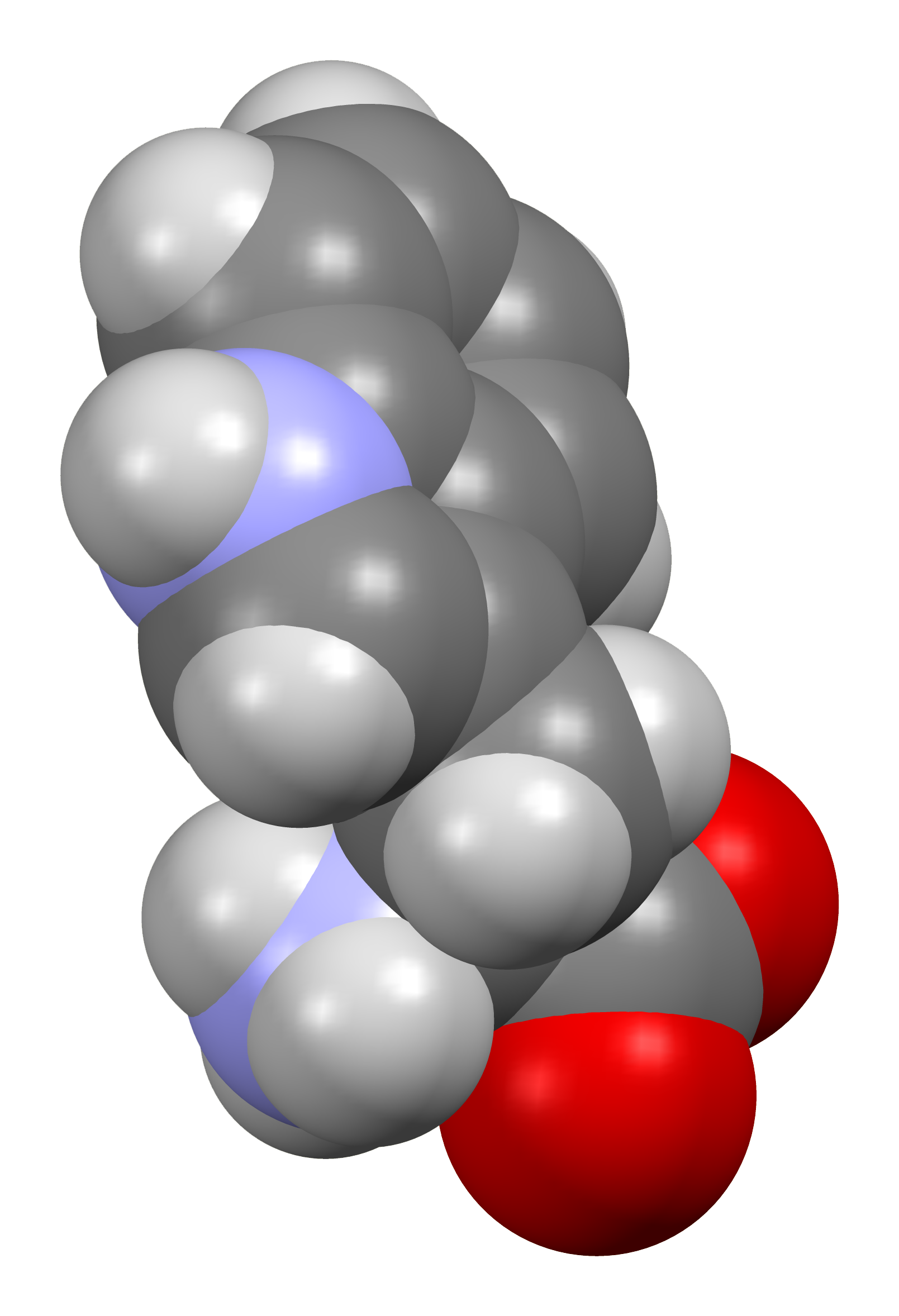It has a sweet, pungent benzene like odor. Toluene has a molecular weight of 92.14 g mol−1. At 25 °C, toluene has a solubility in water of 526 mg l−1, an estimated vapor pressure of 28.4 mm Hg and a Henry’s Law Constant of 6.64 × 10−3 atm-m3 mol−1(USEPA, 2011). The log octanol/water partition coefficient (Kow) is 2.73. Conversion factors for toluene in air are as follows: 1 mg m−3 = 0.27 ppm; and 1 ppm = 3.77 mg m−3.
If released to air, the moderate vapor pressure predicts that toluene will exist solely as a vapor in the ambient atmosphere. Vapor-phase toluene will be degraded in the atmosphere by a reaction with photochemically produced hydroxyl radicals; the half-life for this reaction in air is estimated to be 2 days (USEPA, 2011).
If released into water, toluene would only moderately adsorb to suspended solids and sediment based on an estimated Koc of 235. Volatilization from water surfaces is expected to be the dominant fate process based on the estimated Henry’s Law Constant. Estimated volatilization half-lives for a model river and model lake are 1 h and 4 days, respectively (USEPA, 2011). Biodegradation is expected to occur rapidly in water, with reported half-lives of 4 and 56 days in aerobic and anaerobic water, respectively. Hydrolysis is not expected to be an important environmental fate process since this compound lacks functional groups that hydrolyze under environmental conditions.
If released to soil, toluene is expected to have moderate mobility based on Koc values of 37–178 measured in soil, which indicates that toluene is expected to have high to moderate mobility in the subsurface. Volatilization of toluene from moist soil surfaces is expected to be an important fate process. Toluene may volatilize from dry soil surfaces based on the moderate vapor pressure. Complete biodegradation of toluene was observed in laboratory microcosm tests during a 40 h incubation period using soils previously exposed to toluene. The biodegradation half-life in various soils was reported as several hours to 71 days (HSDB, 2011).
Using a measured log Kow of 2.36, the USEPA’s EPI Suite computer program estimates both bioconcentration factor (BCF) and bioaccumulation factor (BAF) of 38. These predicted bioaccumulation and biomagnification values are very low. Toluene would therefore not be expected to be found in the tissues of fish or wildlife as: (1) toluene contains no persistent functional groups (e.g., chlorine, bromine); (2) exposure would be expected to be low based on a low half-life in the environment; and (3) subsequent to exposure, trace levels of toluene would be rapidly metabolized by the liver (similar to what is seen with other organic compounds).
Uses
Most toluene is added to automobile or aviation gasoline mixtures (benzene⩾xylene⩾toluene) to increase octane ratings. Toluene is an excellent organic solvent and is used extensively in the manufacture of benzene derivatives, caprolactam, saccharin, medicines, dyes, perfumes, TNT, toluenediisocyanates (polyurethane resins), toluene sulfonates (detergents); as a solvent for scintillation counting; in paints and coatings, gums, resins, rubber; and as a diluent and thinner in nitrocellulose lacquers, plastic toys, and model airplanes. Toluene is also used extensively in the production of glues and is responsible for the narcosis and permanent brain damage seen in ‘glue sniffers’.
Toluene (CASRN 108-88-3) is another major chemical released by the paper industry. Toluene, a.k.a. methyl benzene, is a clear, flammable, water-insoluble liquid with the odor of paint thinner. It can be found naturally in petroleum crude oil. Exposure to toluene can occur through air, water, soil, and groundwater, but almost all of the toluene released as emissions is dispersed into the air. Industrial emissions, car exhausts, and cigarette smoke (cigarettes contain about 80 μg/cigarette) are three large sources of atmospheric toluene.
The EPA has labeled toluene as an HAP and a toxic substance. Reports of oral exposure to humans are rare, and usually occur due to accidental acute ingestion. Ameno et al. (1989) reported 15 deaths by oral ingestion between 1977 and 1986. The cause of death was believed to be severe central nervous system depression. Caravati and Bjerk (1997) discussed a case where a 46-year-old man ingested nearly 1 quart of paint thinner containing toluene. The man experienced severe central nervous system depression, severe abdominal pain, diarrhea, and hemorrhagic gastritis. He recovered after 36 hours of supportive care. Repeated exposure to toluene can cause permanent central nervous system effects, and can damage the liver, kidney, and upper respiratory system.
Exposure through inhalation is much more common. People “huff” or “sniff” paint, paint thinner, or glue in order to feel the euphoric effects of a large dose of toluene. Inhalation of toluene can lead to a variety of neurologic manifestations, including ataxia, tremor, anosmia, sensorineural hearing loss, dementia, corticospinal tract dysfunction, and epileptic seizures (Hormes et al., 1986). Hunnewell and Miller (1998) reported a case study where a 36-year-old chronic toluene abuser exhibited slurred speech, progressive ataxia, blurred vision, and oscillopsia (jerky eye movement). High concentrations (10,000–30,000 ppm) can cause narcosis and death. A study in France on workers chronically exposed to toluene fumes reported leukopenia and neutropenia. Exposure levels were not given, but the average urinary excretion of hippuric acid, a metabolite of toluene, was given at 4 g/l compared to the normal level of 0.6 g/l (Sandmeyer, 1989). Table 6.21 shows toxicological data for toluene obtained by the EPA and OSHA.
Toluene (Methylbenzene)
Toluene (methylbenzene) is a natural substance of gasoline and crude oil. It is also used for synthesis of benzene and other chemicals, including graphic pigments, paints, and solvents. It is a highly lipophilic white matter toxin resulting in loss of myelin in cerebral and cerebellar white matter, as well as in diffuse cerebral and cerebellar atrophy.20,21 Intentional abuse occurs through inhalation of toluene vapors from a rag soaked in paint or from a paper bag filled with paint or lacquer thinners, which contain toluene as principle component. While the prevalence of toluene abuse in the United States is unknown, it is estimated that 10% to 15% of people have used the inhalant.22 Prolonged exposure to toluene vapors may result in multifocal leukoencephalopathy, with primary clinical manifestations of dementia, ataxia, brain-stem dysfunction, and corticospinal weakness. Dementia is the most disabling aspect of the syndrome, characterized by apathy, memory loss, visuospatial deficits, and preserved language function. Leukoencephalopathy of toluene abuse is evident on MRI scans and on postmortem examinations.23
In advanced cases, the pattern of multifocal white matter disease can suggest a diagnosis of multiple sclerosis in a young adult, if abuse history is not obtained.24 Diagnosis, however, is usually clear and is based, in an acute setting, on solvent-smelling breath, perioral “huffer's” rash, and appropriate history. Toxicological screening can detect toluene in the blood; hippuric acid analysis of urine is also helpful.
Prolonged, low-level occupational exposures to pure toluene are rare; most industrial exposures include solvent mixtures and cause a so-called solvent syndrome, resulting in change in personality and progressing to permanent cognitive impairment.
Toluene, an aromatic alkylbenzene hydrocarbon compound is often present in paints, lacquers, glues, and solvents. Gasoline, containing up to 7% toluene by weight, represents the most significant source of toluene used in this country.8 Myriad accounts of cases of acute and chronic toluene-induced encephalopathy exist and occur in the setting of accidental or intentional inhalation. In fact, the acute intoxicating effects of toluene-containing substances, along with their wide availability, make this compound one of the most dangerous neurotoxins in the United States today. Recreational use of glues, gasoline, and paints for their intoxicating effects is likely underestimated by many.
Acute toluene toxicity results in lightheadedness and euphoria. Incoordination, disequilibrium, confusion, and cognitive and memory deficits accompany these symptoms. Inappropriate behavior, mood fluctuations, and nystagmus are also common. With higher levels of exposure, unconsciousness, coma, and death may occur. The acute CNS effects of toluene reverse quickly after cessation of the exposure. Repeated exposures, however, can lead to chronic symptoms of intention tremor, motor incoordination, and cognitive deficits. Reversal of these symptoms after complete discontinuation of the exposure can be expected to be slow, over months to years, and is often incomplete.9,10
Its chemical structure makes toluene highly lipid soluble. It readily crosses the blood–brain barrier (BBB) and has an affinity for white matter. There is evidence that toluene causes not only myelin breakdown but also neural cell death. The mechanism of neural toxicity has not been fully established; it is unclear whether this is a direct effect or is secondary to the production of free radicals. Some evidence shows toluene may also alter neuronal response to certain neurotransmitters.6,7
The American Conference of Governmental Industrial Hygienists (ACGIH) has established exposure indices for workers at risk of toluene exposure. Urine hippuric acid levels are recommended at the end of shifts as a means of monitoring levels. Blood toluene levels may also be used. Neuroimaging studies typically reveal diffuse atrophy and decreased gray–white differentiation. Lesions of the basal ganglia are not thought to be caused by toluene exposure but may be present due to concomitant methanol exposure.7 In cases of recreational exposure, diagnosis is based on history and index of suspicion. The clinician must often ask directly about such exposure, as the recreational user is often reluctant to volunteer this history. Aside from removal of the toxic source, no direct treatment exists for toluene toxicity and care is supportive only.
| PubChem CID |
1140 |
| Structure |
|
| Chemical Safety |
|
| Molecular Formula |
C7H8 or C6H5CH3 |
| Synonyms |
toluene
methylbenzene
toluol
108-88-3
Benzene, methyl-
|
| Molecular Weight |
92.14
|
| Dates |
- Modify
2022-02-18
- Create
2004-09-16
|
Toluene appears as a clear colorless liquid with a characteristic aromatic odor. Flash point 40°F. Less dense than water (7.2 lb / gal) and insoluble in water. Hence floats on water. Vapors heavier than air. May be toxic by inhalation, ingestion or skin contact. Used in aviation and automotive fuels, as a solvent, and to make other chemicals.
Toluene is a clear, colorless liquid with a distinctive smell. Toluene occurs naturally in crude oil and in the tolu tree. It is also produced in the process of making gasoline and other fuels from crude oil and making coke from coal.Toluene is used in making paints, paint thinners, fingernail polish, lacquers, adhesives, and rubber and in some printing and leather tanning processes.
Toluene is an aromatic hydrocarbon composed of a benzene ring linked to one methyl group. Toluene is used a solvent or as a chemical intermediate in various industrial applications. Rapid inhalation of high concentrations of toluene can cause severe neurological complications.
|
















